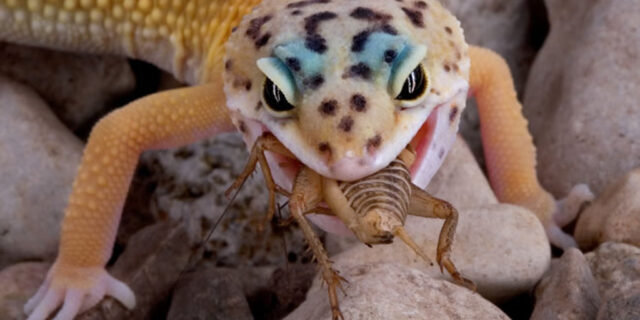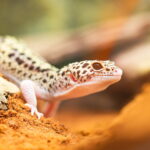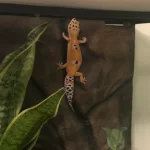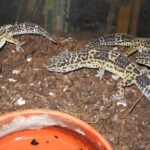Leopard geckos are insectivores, relying heavily on insects for nutrition. In the wild, their diet includes insects like crickets and mealworms, along with spiders and occasionally small mammals. These reptiles are also nocturnal, meaning they’re most active and prefer to hunt at night.
To mimic their natural hunting patterns, it’s best to feed leopard geckos live insects during evening hours. Observing this schedule not only aligns with their instincts but also promotes a healthier, more active lifestyle.
Table of Contents
Feeding Patterns: Baby vs. Adult Leopard Geckos
Feeding habits differ greatly between baby and adult leopard geckos. Baby geckos are often cautious with food, especially live insects, but as they grow, they become more confident hunters.
| Stage | Feeding Frequency | Diet Suggestions |
|---|---|---|
| Baby | Daily | Small insects like pinhead crickets, mealworms |
| Juvenile | Every 1-2 days | Medium-sized crickets, mealworms, waxworms |
| Adult | Every 2-3 days | Larger insects like crickets, dubia roaches |
Tip: Feed baby geckos smaller, more manageable prey to avoid choking and promote easier digestion.
Adapting to New Environments
When first brought home, leopard geckos may take some time to adapt to their new surroundings, which can affect feeding habits. They might hesitate to eat or shy away from food, especially if they feel exposed.
Tips for New Owners:
- Provide Privacy: Feed your gecko in a quiet, low-traffic area to reduce stress.
- Add Hiding Spots: Create hiding spaces in the enclosure to help your gecko feel secure.
- Offer Small Portions: Start with a few insects to gauge their comfort and hunger level.
Over time, they’ll adjust and become more comfortable, making feeding time less stressful for both the gecko and the keeper.
Feeding Frequency and Normal Patterns
A healthy leopard gecko will generally follow a regular feeding schedule. Juveniles need more frequent feedings due to their rapid growth, while adults can be fed less often.
Feeding Frequency Table
| Gecko Age | Feeding Frequency |
|---|---|
| Baby | Daily |
| Juvenile | Every 1-2 days |
| Adult | Every 2-3 days |
Changes in feeding habits, especially if they stop eating, may indicate health issues, stress, or upcoming shedding.
Shedding and Its Impact on Feeding
Shedding is a natural process for leopard geckos that often disrupts their feeding routine temporarily. During this time, they may lose interest in food due to physical discomfort.
To support your gecko during shedding:
- Provide a Moist Hide: Place a damp hide to help ease shedding.
- Mist the Enclosure: Increase humidity slightly to support the shedding process.
After shedding, they typically resume regular feeding, so a temporary reduction in appetite isn’t usually a cause for concern.
Feeding Techniques for Captive Leopard Geckos
Creating a diet that mirrors a gecko’s natural feeding habits is crucial. Offering a variety of live insects promotes interest in feeding while providing balanced nutrition.
Types of Common Feeder Insects:
- Crickets: High in protein, easy to digest
- Mealworms: Good source of fat and protein
- Dubia Roaches: Nutritious and easier to digest than crickets
- Waxworms: High-fat treat, best used occasionally
Gut-Loading and Supplementation:
- Gut-Loading: Feed nutritious foods to insects before offering them to your gecko, enhancing the insect’s nutrient content.
- Dusting with Calcium: Dust insects with calcium powder before feeding to prevent bone-related health issues.
Feeding Tips for Optimal Health
Ensuring a balanced and nutrient-rich diet is essential to prevent common health issues in leopard geckos.
Important Tips:
- Feed at Night: Match your gecko’s nocturnal activity by feeding during evening hours.
- Size Matters: Insects should be no larger than the space between your gecko’s eyes.
- Rotate Food: Offer a variety of insects to prevent dietary monotony.
Sample Weekly Feeding Schedule for an Adult Gecko
| Day | Feeder Insect | Supplement |
|---|---|---|
| Monday | Crickets | Calcium |
| Tuesday | Mealworms | Multivitamin |
| Thursday | Dubia Roaches | Calcium |
| Saturday | Crickets | None |
| Sunday | Waxworms (as treat) | None |
Following a structured feeding schedule helps maintain balanced nutrition and prevents obesity.
Common Feeding Issues and Solutions
Leopard geckos can sometimes exhibit issues related to feeding. Here’s how to handle common problems:
- Refusal to Eat: Stress, environment changes, or shedding may cause temporary feeding refusal. If refusal persists for over a week, consult a vet.
- Selective Eating: Some geckos may favor specific insects. Rotating food choices keeps them interested and ensures balanced nutrition.
- Sickness or Injury: If your gecko shows signs of illness or injury, seek veterinary advice and consider supportive feeding options if they refuse solid foods.
Signs of a Healthy Feeding Routine
A leopard gecko that’s eating well will show steady weight gain in its juvenile stages and maintain a healthy body weight as an adult. Monitoring these indicators is essential to ensure your gecko’s overall health.
Key Health Indicators:
- Regular interest in food
- Steady weight gain (juveniles) or stable weight (adults)
- Active, alert behavior around feeding times
Final Takeaways: Ensuring Dietary Health for Leopard Geckos
Feeding leopard geckos requires understanding their natural behaviors and creating an environment that encourages healthy feeding. A diet of live, varied insects enriched with calcium and other supplements provides essential nutrients that are crucial for growth, health, and vitality.
Maintaining a feeding routine based on their nocturnal activity and ensuring a balanced diet supports their well-being. By monitoring their feeding patterns, keeping up with dietary needs, and consulting a vet if unusual feeding behavior persists, you can create a rewarding experience for both you and your gecko.
With the right diet and care, leopard geckos can lead a long, healthy, and active life, enriching the bond with their keepers.





